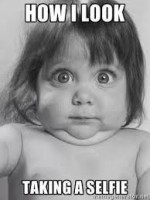International Women's Day and Selfies.
 On this International Women’s Day, I’m reading a book called “American Girls” by Nancy Joe Sales. It’s a fascinating look at how social media affects girls between 13-19.
On this International Women’s Day, I’m reading a book called “American Girls” by Nancy Joe Sales. It’s a fascinating look at how social media affects girls between 13-19.
Note: Of course, not all girls are so involved. And of course the problem isn’t limited to ‘girls’ — a term Sales recognizes as problematic in terms of contemporary gender classification, but which she uses, and which I use here, to define a specific group of people, of a certain age who self-define as heterosexual. Similar issues exist within the LGBT community and similar concerns apply.
One of the things I find so disturbing (and there are lots of disturbing things in this book), is hypersexualization of girls, who become increasingly addicted to approval from others on websites like Snapchat and Instragram, based solely on their physical appearance. “Boobs and butt” pictures abound, as do nude shots sent to boys, which are inevitably passed around like baseball cards once were, with predictable results.
They panic if they don’t get lots and lots of ‘likes’ on these selfies. They live for the comments: “Gorgeous” “Lips! Goal!” — as in, “It’s my goal to have lips like yours!”– “Perfect!” “Flawless!” They spend hours primping for selfies, taking 70 or more photos to get one they like. In some cases their mothers, hoping perhaps for a vicarious popularity they never had, take their daughters to professional hair dressers and make up artists in preparation for selfies, to make sure their “brand” is perfect. (One can’t help but speak in air quotes when discussing this sort of thing. To quote a Newfoundland expression, Jesus in the garden!)
It will come as no surprise that the Kardashians are their idols, along with a smattering of bloggers and youtube stars, who earn money by telling girls what makeup to wear. It’s the Kardashians, famous for being beautiful and rich, who preen and pose at the top of the heap and who they most wish to emulate. The book “Selfie”, Kim Kardashian’s ode to herself, sends the girls into spasms of delight. A book, I should add, that the Globe & Mail named one of the best of the year in 2015. I still pray they were being ironic, although I’m told they — and others in the media — perceived the book as a sly knowing wink from Kardashian. I remain unconvinced.
There are a million reasons why this sort of thing is worrying. But I am a writer and therefore all I can really speak to is the field of artistic endeavor.
It is the job of the artist to dig deep, to see what others don’t, to see ordinary things in a new way and to guide the reader/viewer to a new perception. It is the job of the artist to speak for those who cannot speak for themselves. It is the job of the artist to search for the truth of a matter and drag that truth into the light. We must look at things, and people, and places, and institutions, and accepted cultural practices and challenge them. Artists should be dangerous. We should strive to say the unpopular, the unspeakable, the revolutionary. It is no surprise that totalitarian regimes silence artists first.
Women, it has been argued in the past (I like to think of it as the past, although I am often disappointed in the present), don’t have what it takes to be great artists. We are told we are the voice, at best, of the domestic, of the romantic, not the political, not the cultural.
I disagree, of course. But I can’t help but wonder what books will be written by young women lured into the addiction of narcissism and popularity based on such shallow considerations? What films will be made, if any, by a woman raised on selfies of her butt and the desire to get lots of ‘likes’ for it? Will a duck-pout, cleavage-obsessed youngster grow up to create a new form of dance? A new school of visual art?
This addiction is created by a cynical system of corporate commercialism — trapping the young into life-long habits of insecurity, who will in turn become life-long consumers rather than rabble-rousers, art-makers, rebels and revolutionaries.
If one is obsessed with popularity, art will fail. It will be the blandest, most commercial sort of pap. We are already hobbled by a publishing industry where many of the large publishing houses are concerned only with sales, and rarely with literature. And honestly, the world doesn’t need more “50 Shades” of anything, does it? You simply can’t create great art if you’re concerned with how many ‘likes’ it will receive. Sure, all artists hope to find an audience, and even Henry James bemoaned his lack of sales. There’s nothing wrong with hoping one can make a living from one’s art. But that creative fire, that deep and sustaining flame, will be extinguished by a desire for fame, wealth and luxury goods — the trappings of contemporary popularity.
Artists can’t desire popularity more than they desire truth.
Malala Yousafzai said: “We must tell girls their voices are important.” I agree. Let’s hope they raise them as Malala did, and be glad she never got hooked on selfies.
Excellent piece Lauren! Happy International Women’s Day!
Thank so much, Kelly. Lovely to hear from you.
As a mother, I think about this every day, Every day! I do what I can to combat it and hope that it is enough. I love this. And, I’m thinking you should write a book about it (fiction, of course!). 🙂
Hi Naomi. Thanks for the comment. You never know what I’ll write about next! (If I write about this I’ll give you an acknowledgement nod, ok?)